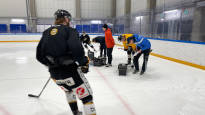Oulun Kärpät, who had success last season, is looking for a more even tone for the upcoming season with the help of Vuokat’s teachings. The idea is that it would be possible to play the jams of several matches without any dips.
Sanna Kähkönen,
Jarmo Nuotio
Fly trainer Lauri Marjamäki has been following for three days how the players have been subjected to strict physical tests. Thursday consisted of physical training, ice test, ice training and other activities.
Central striker Jesse Koskenkorva admits that Vuokatti has drained a lot of sweat from him this week with the bike test and ice training.
– We’ve really gone hard.
The idea of the hard test week is to provide the team’s coaching management with information, especially about the players’ recovery and workload. Data is collected from them, which is used in training.
Under the leadership of the Vuokatti-Ruka sports academy, the team is looking for good and concrete measuring and control tools to support everyday life.
– For example, through nocturnal heartbeats and heartbeat intervals. Then there are also tests that can be done during the training season and check that the players are in the condition they need to be in during the competition season, says Vuokatti-Ruka sports academy expert Mikko Korhonen.
The last test day, which ends at the beach sauna, brings a little relief.
“Feels bad”
Defender Tommi Kivistö says he is from tests with acids. The skating test that has just been done is new for him, as the team has done longer tests in the past.
– It feels bad, Kivistö admits.
Despite the sourness, it is a good thing for Kivistö that the individual and the team get information about where to go.
Information about recovery in particular is important, because the season of a professional hockey player in the league consists not only of training, but also of long competition trips and starting games. In addition to measuring heart rate fluctuations, the quality of the players’ sleep is of particular interest to the measurers.
– As we head towards the competition season, we would have sleep data for each athlete, especially with different devices. With modern technology, they can be monitored and reported here in Kainuu, Korhonen clarifies.
The Kärppie coach gives a practical example of what a league player’s workload is at its heaviest.
– Everyone can imagine when we play on Wednesday, Friday and Saturday, plus flights and everything, and we should still be at our best on Saturday. We have not succeeded in that in recent years, Marjamäki admits.
Everything is aimed at the ice
The analytics built at Marjamäki’s Vuokati camp mean, for example, better planning of ice training, when the team receives information about, for example, match and practice responses.
In this way, the coaching staff is better able to offer the best possible stimulus every day; know for whom you can pull the “organ open”, and for whom a different type of training is better suited.
– We have a 38-year-old Marko Anttila and 18 years old Arttu Alasiuruaand when the age difference is 20 years, one recovers a little faster than the other.
The coming season will also bring Marjamäki a hard rollercoaster during which the most important thing should be taken care of – maximizing performance on the ice. According to Marjamäki, ice hockey players need increased endurance qualities in the summer, which guarantees a better recovery from stress.
In the end, everything is concretized on the ice.
– It doesn’t help, even if you run to China and pull 180 kilos with one leg squats and other things. If nothing happens on the ice, it’s a bit like plus minus zero, summarizes Marjamäki.
